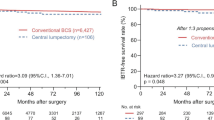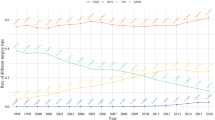Abstract
Purpose
To compare the oncological safety of nipple-sparing breast-conserving surgery (BCS) versus central lumpectomy for centrally located breast cancer (CLBC).
Methods
Patients who underwent BCS for CLBC at Asan Medical Center from 2007 to 2018 were reviewed retrospectively. The oncological outcomes of nipple-sparing BCS (NS-BCS) and central lumpectomy were compared using univariate and multivariate Cox regression analyses and compared again after 1:1 propensity score matching (PSM).
Results
The study included 306 patients who underwent NS-BCS and 106 patients who underwent central lumpectomy (median follow-up: 111 months). On multivariate analysis, central lumpectomy had a lower risk of local recurrence compared to NS-BCS, albeit without statistical significance (HR 0.14, 95% CI 0.02–1.24; p = 0.077). There was no significant difference in the risk of death (HR 0.14, 95% CI 0.01–1.68, p = 0.12). After PSM, each group had 106 patients. The 5-year and 10-year local recurrence-free survival rates were 94.2% and 92.9% for NS-BCS, and 99.1% and 99.1% for central lumpectomy, respectively (p = 0.031). There were no significant differences in overall survival, regional recurrence-free survival, or distant recurrence-free survival. Fifteen patients (4.9%) who underwent NS-BCS had ipsilateral breast tumor recurrence (IBTR), of which 40% were in the nipple-areolar complex and previous surgical sites. One patient (0.9%) who underwent central lumpectomy experienced an IBTR in a different quadrant.
Conclusion
NS-BCS showed more local recurrence than central lumpectomy. When deciding whether to spare the nipple during BCS in CLBC, patients should be sufficiently informed about the risk of IBTR.

Similar content being viewed by others
Data availability
The data analyzed in this study is subject to the following licenses/restrictions: We do not provide datasets publicly, but we may provide datasets through a contract upon reasonable request. Requests to access these datasets should be directed to brdrson@korea.com.
References
Pezzi CM, Kukora JS, Audet IM, Herbert SH, Horvick D, Richter MP (2004) Breast conservation surgery using nipple-areolar resection for central breast cancers. Arch Surg 139(1):32–37
Kroman N, Wohlfahrt J, Mouridsen HT, Melbye M (2003) Influence of tumor location on breast cancer prognosis. Int J Cancer 105(4):542–545. https://doi.org/10.1002/ijc.11116
Lohrisch C, Jackson J, Jones A, Mates D, Olivotto IA (2000) Relationship between tumor location and relapse in 6,781 women with early invasive breast cancer. J Clin Oncol 18(15):2828–2835
Ji F, Xiao WK, Yang CQ et al (2019) Tumor location of the central and nipple portion is associated with impaired survival for women with breast cancer. Cancer Manag Res 11:2915–2925. https://doi.org/10.2147/CMAR.S186205
Theberge I, Guertin MH, Vandal N, Cote G, Dufresne MP, Pelletier E, Brisson J (2019) Screening sensitivity according to breast cancer location. Can Assoc Radiol J 70(2):186–192. https://doi.org/10.1016/j.carj.2018.10.007
Winchester DP, Cox JD (1992) Standards for breast‐conservation treatment. CA Cancer J Clin 42(3):134–162
Liu J, Zheng X, Lin S, Han H, Xu C (2022) Breast conserving therapy for central breast cancer in the United States. BMC Surg 22(1):31. https://doi.org/10.1186/s12893-022-01488-0
Fu WD, Wang XH, Lu KK, Lu YQ, Zhou JY, Huang QD, Guo GL (2022) Real-world outcomes for Chinese breast cancer patients with tumor location of central and nipple portion. Front Surg 9:993263. https://doi.org/10.3389/fsurg.2022.993263
Fitzgibbons PL, Connolly JL, Bose S, Chen YY, De Baca ME, Edgerton M, Hayes DFJCg (2020) Protocol for the examination of resection specimens from patients with invasive carcinoma of the breast. 4(1.0)
Choi JE, Kim Z, Park CS et al (2023) Breast cancer statistics in Korea, 2019. J Breast Cancer 26(3):207
Kim H, Lee SB, Kim J, Chung IY, Kim HJ, Ko BS, Lee JW, Son BH, Ahn SHJPo (2022) Improvement of survival in Korean breast cancer patients over a 14-year period: a large-scale single-center study. PloS ONE 17(3):e0265533
Bradley R, Braybrooke J, Gray R et al (2021) Trastuzumab for early-stage, HER2-positive breast cancer: a meta-analysis of 13 864 women in seven randomised trials. Lancet Oncol 22(8):1139–1150
Eggemann H, Ignatov A, Elling D, Lampe D, Lantzsch T, Weise M, Costa SD (2013) Efficacy and patient satisfaction of breast conserving therapy for central breast cancer by the B technique. Ann Surg Oncol 20(11):3438–3445. https://doi.org/10.1245/s10434-013-3030-6
Shah C, Hobbs BP, Vicini F, Al-Hilli Z, Manyam BV, Verma V, Jia X, Goldstein N, Recht A (2020) The diminishing impact of margin definitions and width on local recurrence rates following breast-conserving therapy for early-stage invasive cancer: a meta-analysis. Ann Surg Oncol 27(12):4628–4636. https://doi.org/10.1245/s10434-020-08878-9
Bundred JR, Michael S, Stuart B et al (2022) Margin status and survival outcomes after breast cancer conservation surgery: prospectively registered systematic review and meta-analysis. BMJ 378:e070346. https://doi.org/10.1136/bmj-2022-070346
Fitzal F, Bolliger M, Dunkler D et al (2022) Retrospective, multicenter analysis comparing conventional with oncoplastic breast conserving surgery: oncological and surgical outcomes in women with high-risk breast cancer from the OPBC-01/iTOP2 study. Ann Surg Oncol 29(2):1061–1070. https://doi.org/10.1245/s10434-021-10809-1
Boehm DU, Lebrecht A, Maltaris T, Schmidt M, Siggelkow W, Fischer S, Kandelhart E, Koelbl H (2008) Influence of resection volume on locoregional recurrence of breast cancer after breast-conserving surgery. Anticancer Res 28(2B):1207–1211
Fitzal F, Mittlboeck M, Trischler H, Krois W, Nehrer G, Deutinger M, Jakesz R, Gnant M (2008) Breast-conserving therapy for centrally located breast cancer. Ann Surg 247(3):470–476. https://doi.org/10.1097/SLA.0b013e31815b6991
Author information
Authors and Affiliations
Corresponding author
Ethics declarations
Statements and Declarations
The authors declare that no funds, grants, or other support were received during the preparation of this manuscript. The authors have no relevant financial or non-financial interests to disclose. All authors contributed to the study conception and design. Material preparation, data collection and analysis were performed by Yung-Huyn Hwang and Byung Ho Son. The first draft of the manuscript was written by Yung-Huyn Hwang and all authors commented on previous versions of the manuscript. All authors read and approved the final manuscript. The datasets generated during and/or analyzed during the current study are not publicly available due to their containing information that could compromise the privacy of research participants but are available from the corresponding author on reasonable request. All procedures performed in this study involving human participants were in accordance with the ethical standards of the institutional and/or national research committee and with the 1964 Helsinki Declaration and its later amendments or comparable ethical standards. This study was approved by the institutional review board of Asan Medical Center (IRB no. 2022–0282). Informed consent was waived because the study was based on retrospective clinical data.
Additional information
Publisher's Note
Springer Nature remains neutral with regard to jurisdictional claims in published maps and institutional affiliations.
Supplementary Information
Below is the link to the electronic supplementary material.
Rights and permissions
Springer Nature or its licensor (e.g. a society or other partner) holds exclusive rights to this article under a publishing agreement with the author(s) or other rightsholder(s); author self-archiving of the accepted manuscript version of this article is solely governed by the terms of such publishing agreement and applicable law.
About this article
Cite this article
Hwang, YH., Yoo, TK., Lee, S.B. et al. Comparison of long-term oncological outcomes after central lumpectomy versus nipple-sparing breast-conserving surgery for centrally located breast cancer: a propensity score-matched study. Breast Cancer Res Treat 205, 117–125 (2024). https://doi.org/10.1007/s10549-024-07267-0
Received:
Accepted:
Published:
Issue Date:
DOI: https://doi.org/10.1007/s10549-024-07267-0




